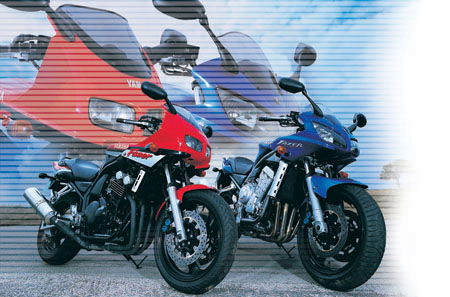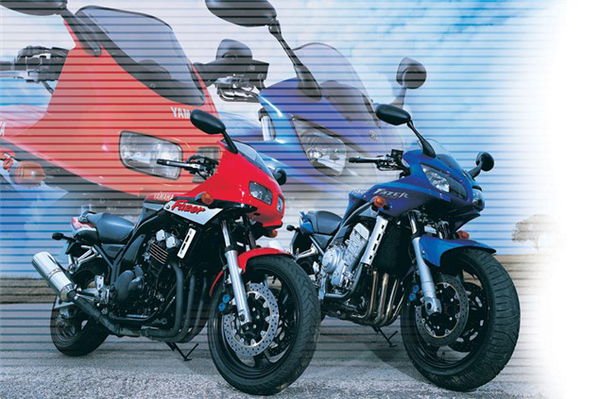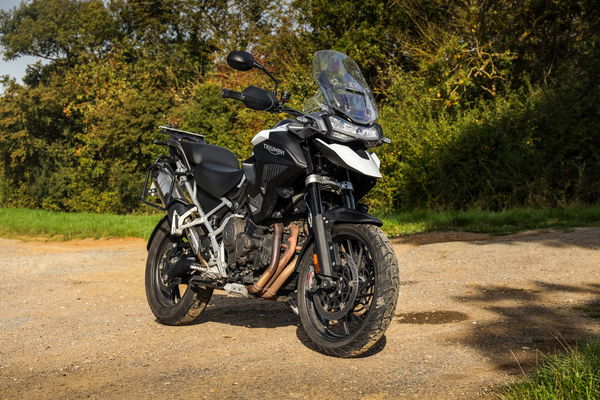Road Test: Yamaha FZS600 V FZS1000
Looking at buying either a 600 or 1000 Fazer but can't make your mind up? Do the running and retail costs of the 1000 put it in a different league to its little budget brother? All that and more inside. Lovely.

 |
When you're buying a new bike, unless you've got money coming out of your ears good value is just as important as other more obvious attractions like a stonking motor, razor-sharp handling, and drop-dead styling. The bike doesn't necessarily have to be cheap, though that's always a bonus, of course. Just as long as you're sure you're getting the motorcycle that you want, and the bike offers value for money, then it's worth handing over the dosh - whether that's two or 20 grand.
And on that note, that's precisely how Yamaha's 600 and 1000 Fazers differ. One has a bargain price tag, the other a price tag for profit. One's a steal, the other's just plain steep.
To be fair both Fazers are excellent bikes. They're fast and handle well enough to stay with far more exotic tackle. Practical and comfy enough to lark about on all day, they're also dead easy to ride fast or slow and above all bloody entertaining motorcycles in just about any situation. But when it comes to sheer value and putting all those qualities in financial context there's one clear winner. But which one is it?
On the face of it the 600 looks likely. It can be yours for just £5,299, a massive £2,800 cheaper than the 1,000cc version which commands a heady £8,099. But don't forget, value isn't just about price - it's what you get for your money. And the 600 has plenty, including a retuned engine from the YZF-Thundercat capable of over 130mph, stunning brakes from the R1, a twin headlight fairing, and styling to help you stand out from the crowd.
But on the face of it, you get a load more from the Fazer 1000 model. A stack more power for starters, courtesy of an engine straight out of the amazing 20-valve, four-cylinder R1 superbike, which pumps out nearly 40bhp more than the 600, and will take you to over 150mph in very little time. You get the same stonking brakes, fully adjustable suspension, and all clothed attractively in sleek athletic-looking bodywork.
The question being, is that superior specification worth digging deeper into your wallet for? Do you actually need that R1 power, or does the 600 pack plenty enough punch? Let's dive in, have a closer look at the two Yamaha Fazers, and make a judgement.
They might share a name and basic design layout, but the two Fazers have a very different style to set them apart. They look so different there's never a chance of mistaking one for the other. And unfortunately for the 600, its old-world, slabby retro shape doesn't win it too many fans. Luckily, it has so much riding appeal once you get it going, the 1980s bodywork becomes less of an issue.
The bigger Fazer on the other hand has a thoroughly up-to-date look, with its sleek, sharp and sexy style emphasised by the racy R1-esque nose cone. And the fact it's powered by an R1 motor, even if it has been strangled a bit with mods like smaller carbs to make it a bit more manageable, gives it masses of street cred.
The Fazer 1000 is quite a bit physically bigger than the 600, and at a standstill you notice the 19kg weight difference. Get them moving though, and the wider bars of the bigger bike provide enough leverage to manhandle it around nearly as easily. For a budget 600 the baby Fazer is an impressive bike, and has a very strong motor. Considering its small capacity and conventional four-cylinder layout, torque and flexibility are surprisingly strong.
If you want to up the pace a bit you won't have to dance on the gearlever as often as you'd think - the Fazer 600 comes packed with midrange grunt. If you do decide to cane it even harder and get the tacho needle nearer its redline then the acceleration won't disappoint. Get your head down and you'll see 140mph on the speedo, which for a bike of this price is damn good going.
Not - obviously - as good as the bigger Fazer. And although the 1000 isn't quite as mad as you'd expect with that R1 lump being slightly detuned, it's still mad enough to hoist the front wheel up with ease and get things moving very rapidly. There's no substitute for cubes at the end of the day, and the 120-odd bhp reaching the Fazer's rear tyre is very seductive.
You'll only get the very best from it if you play with its slightly notchy gearbox and rev it a bit, but overall the motor is far stronger than the 600's. Which is what you'd expect. In fairness if you're prepared to squeeze every last drop of power from the smaller Fazer by caning it to near death, you won't get left behind as much as you'd expect. And if there's a few corners to howl around the deficit will be reduced even further.
Both Yamahas handle well, but the suspension of the 1000 needs to be firmed up if you want to play hard. Luckily it is fully adjustable, and generally you'll be looking at running the rear shock with maximum rebound damping to keep the arse-end in check when you're getting a clatter on.
Chucking the 1000 around takes little effort thanks to those wide bars, which let you dominate the bike and lever it onto its side without effort. It won't take long before you start bashing stuff like the footrests and the end can off the road if you get really enthusiastic which is an unfortunate restriction, but for a bike in this class handling really is very good indeed.
As is the 600's. Unlike its bigger brother there's no need to fiddle with damping adjusters to get the suspension to perform well. Which is handy because there aren't any fitted, anyway. Only the forks and rear shock's preload are adjustable. Straight from the off, the 600 Fazer can be hustled around at any speed and feel safe. Its skinny 110-section front tyre helps speed up the steering, and like the bigger Fazer, it's not long before sparks are flying from the bike's undercarriage when you heel it over.
Brakes on both bikes are wicked. The one-piece four-piston calipers have done the rounds on the R1 and R6 sportsbikes and proved their worth. And they work just as brilliantly on the Fazers, hauling them up sharply and safely.
Both bikes are good all-rounders and as happy touring the countryside as they are at scratching. Their riding positions and plush seats mean they're comfortable all day long, and though their fairings might not look up to much, they provide enough protection to make 100mph cruising painless. Add other features like centrestands, clocks, fuel gauges, and bungee hooks, and you can see why the Fazers are so practical and easy to live with.
The fact is, the bigger Fazer is the better bike. Its biggest advantage is (surprise) that motor, which is much more powerful than the comparatively revvier 600's. You don't have to spin it up anywhere near as much to get the best from it, and overall it gives the bike a much more exciting feel. Jump back on the 600 Fazer after hooning around on the 1000, and frankly it feels a bit flat and uninspiring. But to be fair, it doesn't take long to get used to the lesser power, and you soon realise that the smaller Fazer can still move at an impressive pace.
Handling is an area where the 600 scores a few more points over the 1000, and the two bikes are fairly equal in all other areas like braking, comfort, equipment and practicality. But overall the bigger bike's attitude, credibility, style and excitement give it an advantage.
But, and this is a very big BUT, there's a price for all this superiority. And it's a price that's just too high.
The smaller Fazer, which rings the tills at just £5,299, belies its budget badge and rides like something worth a £1,000 more. In contrast, the £8,099 Fazer 1000 version rides like something worth a grand less. The big bike is a rocking tool, it's just not rock 'n' roll enough to justify its heavy cost. Both Fazers are the best bikes in their respective classes, but while the bigger model might beat its opposition on the road, it can't hold a candle to them at the tills.
For its price the 600 is very hard to fault and, questionable styling aside, has won the hearts of many bikers, experienced and inexperienced alike. A brand new bike with the sort of performance it has, and for the money it goes for deserves to be heralded as one of the best deals around. The bigger bike, despite its many virtues, does not.
If you worship at the altar of performance, and spending the extra to buy and run the bigger Fazer doesn't hurt, then choose that. If however you want some value from your motorcycle then look no further than the 600. It's a bargain, and a top motorcycle, too.
Both Fazers are powered by water-cooled, four cylinder DOHC engines, based on those fitted in sportier Yamahas, the R1 and YZF-Thundercat being the donor models. The Fazer 1000's 123bhp engine has the advantage of a 20-valve cylinder head, and an EXUP valve in the exhaust to effectively alter the pipe's internal geometry and boost midrange power.
The Fazers use carburettors fitted with throttle position sensors. The 1000 has four 37mm items, the 600 a set of smaller 33mm versions. A one-piece upper crankcase and cylinder block makes the bigger Fazer's motor more rigid. And its stacked gearbox, which sits above the crankshaft, makes the engine more compact.
Chassis arrangements are more basic and very similar. Each Fazer uses a steel tube double cradle design, though the bigger bike has large-diameter 49mm diameter tubes for extra strength, and features alloy swingarm pivot plates. The geometry of the bigger machine is the slightly more relaxed of the pair with a longer wheelbase and trail.
Both Fazers use conventional telescopic forks, and a rising-rate monoshock unit. The 1000's 43mm forks are 2mm thicker in diameter and fully adjustable. The more basic 600's forks only have preload adjustment. Similarly the bigger bike's rear shock features full adjustment, whereas the 600's can again only be altered for preload.
Brakes are virtually identical on both, and are the same as fitted to the R6 and R1 superbikes. The one-piece four piston calipers offer exceptional stopping power.
The 1000 Fazer weighs in at 208kg, a whole 19 kilos more than the 189kg 600.
COST OF LIVING
TYRES
The 600 comes on Bridgestone BT57s in sizes 110/70 ZR17 on the front and 160/60 ZR17 on the rear. The 1000 is on Metzeler MEZ4 rubber. Sizes are 120/70 ZR17 front and 180/55 ZR17 rear.
The Bridgestones are a good choice for the 600 with excellent grip, stability and wear rates. However the BT57 has been replaced by the BT010, so the BT57s can be hard to find. Have no worries about fitting the BT010s. They have all the all-round qualities of the BT57s and offer more grip. A pair costs just under £200, fitted and balanced to loose wheels. Expect 4,000 to 8,000 miles from 'em.
The Metzelers on the Fazer 1000 won't last that long because of its extra weight and power - expect 3,000 to 5,000 miles. The MEZ4s need to be warmed well to offer the best grip and don't always perform as tenaciously in wet conditions. But they are very stable, even if they do slow the steering a little. A new pair costs £220 to have fitted and balanced to a set of wheels.
Overall tyre bills for the bigger bike will be around 60% higher.
FUEL ECONOMY
Fuel bills are slightly higher on the 1000, which returns an average of 39mpg compared to the 600's typical 41mpg.
But the extra capacity of the 1000's 21-litre tank gives it a slightly longer range of 180 miles, compared to the 600's 160 miles from its 18-litre tank. It's easy to increase this to a practical 200 miles on either bike if you're less enthusiastic with the throttle, giving the Fazers some practical touring appeal. Hard drivin' will have both dropping to 130 miles.
Even so, with a fuel gauge and low level warning light (which comes on with around 3 litres left) fitted to both Fazers, there's no real excuse for running dry.
DEPRECIATION
It's tricky to calculate how much the Fazer 1000 will be affected by depreciation as it's so new, and popularity and demand are uncertain. For the moment expect to lose up to £2,000 after a year or 3,000 miles.
The 600's appeal on the other hand is well known. It's extremely popular, especially with newer riders, and will only lose about £500 after a year's use. Even after two years, as long as the mileage isn't too high, its value should only drop by £800-£1,000.
Like the bigger bike, this loss depends entirely on how well you've looked after the bike.
Bargaining for a new 600 is tricky because of high demand. And it remains to be seen how much dealers will be willing to knock off the price of a new 1000 Fazer. I suspect the cheaper price of its closest competitors may have an effect before long, and force them to discount the Fazer 1000.
SPECS - FZS600
TYPE - STREETBIKE
PRODUCTION DATE - 2001
PRICE NEW - £5299
ENGINE CAPACITY - 599cc
POWER - 84bhp@11,400rpm
TORQUE - 43lb.ft@8000rpm
WEIGHT - 204kg
SEAT HEIGHT - 790mm
FUEL CAPACITY - 18L
TOP SPEED - 139mph
0-60 - n/a
TANK RANGE - N/A
SPECS - FZS1000
TYPE - STREETBIKE
PRODUCTION DATE - 2001
PRICE NEW - £8099
ENGINE CAPACITY - 998cc
POWER - 123bhp@9750rpm
TORQUE - 72lb.ft@7500rpm
WEIGHT - 208kg
SEAT HEIGHT - 820mm
FUEL CAPACITY - 21L
TOP SPEED - 155mph
0-60 - n/a
TANK RANGE - N/A

When you're buying a new bike, unless you've got money coming out of your ears good value is just as important as other more obvious attractions like a stonking motor, razor-sharp handling, and drop-dead styling. The bike doesn't necessarily have to be cheap, though that's always a bonus, of course. Just as long as you're sure you're getting the motorcycle that you want, and the bike offers value for money, then it's worth handing over the dosh - whether that's two or 20 grand.
And on that note, that's precisely how Yamaha's 600 and 1000 Fazers differ. One has a bargain price tag, the other a price tag for profit. One's a steal, the other's just plain steep.
To be fair both Fazers are excellent bikes. They're fast and handle well enough to stay with far more exotic tackle. Practical and comfy enough to lark about on all day, they're also dead easy to ride fast or slow and above all bloody entertaining motorcycles in just about any situation. But when it comes to sheer value and putting all those qualities in financial context there's one clear winner. But which one is it?
On the face of it the 600 looks likely. It can be yours for just £5,299, a massive £2,800 cheaper than the 1,000cc version which commands a heady £8,099. But don't forget, value isn't just about price - it's what you get for your money. And the 600 has plenty, including a retuned engine from the YZF-Thundercat capable of over 130mph, stunning brakes from the R1, a twin headlight fairing, and styling to help you stand out from the crowd.
But on the face of it, you get a load more from the Fazer 1000 model. A stack more power for starters, courtesy of an engine straight out of the amazing 20-valve, four-cylinder R1 superbike, which pumps out nearly 40bhp more than the 600, and will take you to over 150mph in very little time. You get the same stonking brakes, fully adjustable suspension, and all clothed attractively in sleek athletic-looking bodywork.
The question being, is that superior specification worth digging deeper into your wallet for? Do you actually need that R1 power, or does the 600 pack plenty enough punch? Let's dive in, have a closer look at the two Yamaha Fazers, and make a judgement.
They might share a name and basic design layout, but the two Fazers have a very different style to set them apart. They look so different there's never a chance of mistaking one for the other. And unfortunately for the 600, its old-world, slabby retro shape doesn't win it too many fans. Luckily, it has so much riding appeal once you get it going, the 1980s bodywork becomes less of an issue.











